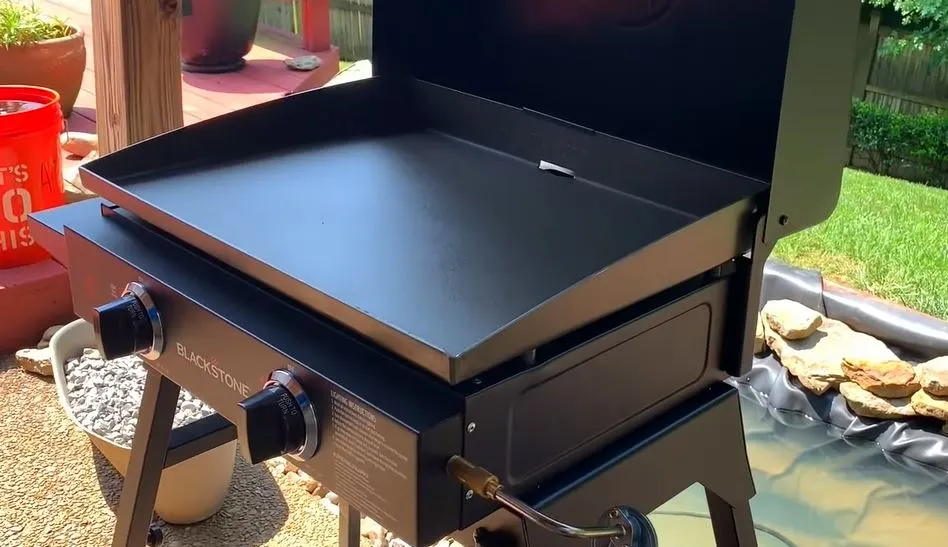This post may contain affiliate links. If you use these links to buy something we may earn a small commission. Thanks.
Do you want your cooking griddle sticky or rusty? I’m guessing not. But I’m also positive that’s exactly what will happen if you don’t know how to season a Blackstone grill for the first time right?
Some users even forgo the whole process altogether, which, no doubt, is worse for your cooking and the life of your equipment.
In any case, this post covers everything you should know on how to season a Blackstone 17 and 22 grill, or any other series for that matter. I’ve made efforts to include some of the best types of oils to use for the process and their smoke point rating.
Why Should You Season a Blackstone Grill?
In simple words, seasoning a grill is a technique of building a protective coat on your cooking surface. It assumes a process called polymerization, whereby you heat particular baked-on oil or fat at temperatures high enough to create a hard black surface.
Blackstone deal in only portable flat-top grills, thereby the cooking surface you’ll be seasoning is a griddle plate. However, the owners with the normal grilling/ smoking grill will also need to season the cooking grids before the first use.
And the importance to season either type of grill includes to:
- Create a Non-Stick Cooking Surface:
Technically, this is one of the main reasons to season your Blackstone flat griddle or the grates/ grids on the other grills. The whole idea’s to create a smooth and glass-like layer on your rough cooking surface.
Yes, yes the cooking surface of the griddle may seem smooth to the eye. But in reality, there are some microscopic pores and cracks that often grab the food when the plate becomes hot.
If you’ve ever cooked on a sticky surface, it’s usually not an enjoyable experience. Food tends to get burnt (or messy on pancakes) easily. Cleanup also becomes harder than it should be.
After seasoning, though, the oil/ fat used will fill in the microscopic pores on the surface and your food won’t stick again. It will just sit on the smooth layers you’ve created and cook nicely as supposed to.
- Curb Corrosion (or Rust)
Rust is the second main reason you should season your grill. Like the griddle on the Blackstone 22 or 28 and 17-Series, it’s a rolled steel material that’s highly prone to rust.
But after seasoning, that layer of oil/ fat you create is usually impermeable (to water and moisture). Thus, protecting your cookware from rust and corrosion that would compromise your cooking and the durability of the whole appliance.
- Get Rid of Toxic Manufacturing Chemicals
When you buy new cookware, it usually has stuck-on chemicals from the material used in the manufacturing. Cleaning and seasoning is the most effective way to get rid of these contaminants before they contaminate your meals.
- Enjoy a Nice, Delicious Grill Meal
Indeed, seasoning does make sure you get to enjoy your grilled food in its true form. One way of doing this is to mask the heated smell from the material used to make the griddle plate. The layers of the baked-on fat or oil you create that needed masking.

Secondly, foods tend to lose some of their juices when they stick and dry out on a cooking surface that’s rough. But after seasoning, you’ll get to taste your meals as they should be.
Thirdly, the oil/ fat you use to season your grill will embellish all your meals with its unique flavor when heated. So, it’s advisable to use a coat of oil that everyone on the table would love- or else go neutral.
- Prevent Scratches
Last but not least, seasoning your Blackstone grill griddle helps prevent scratching, which can occur during cooking or cleaning. And when you prevent scratching, you also protect your grill from the two main issues: food sticking and rust.
What’s the Best Oil to Season a Blackstone Grill for the First Time?
To season a grill, you’ll need to have a good quality oil that will create the desired layers on your cooking griddle. Oils with a high smoke point are the best as you can create a strong seasoning coat that won’t get burnt/ broken down fast.
A perfect example is a particular brand that Blackstone recommends: Blackstone Griddle Seasoning & Cast Iron Conditioner. As the name advertises, it’s a two-in-one product to give your griddle a super-smooth surface with a heavy dark color.
But when you look at the compounds of the Blackstone Two-in-One seasoning conditioner, we have a blend of palm oil, canola oil, soy oil, beeswax, and shortening. Thus, it’s very easy to find an alternative even right from your kitchen.
However, do remember each of these vegetable oils and shortening has a different smoke point (the temperature at which they start to smoke and break down). And that would mean whichever oil you use for the process should fit your cooking style.
For instance, the way you cook a steak in a Cast Iron Skillet is pretty much the same with a Blackstone grill. If it’s searing, the cooking heat will be relatively higher, and that would require your seasoning coat to withstand those temperatures.
In other words, when choosing oils to season your grill (Blackstone or otherwise), use something with a higher smoke point than the cooking temperatures. If the idea’s to cook at 400 degrees, 500ºF oils like refined Avocado Oil or safflower oil should be used.
Tip: Scroll down to see the various oils you can use to season your Blackstone grill and their smoke point rating.
How to Season a Blackstone Grill for the First Time
Seasoning a Blackstone grill is pretty straightforward. And considering it’s a flat griddle plate here, the process should be faster than the grates on the usual grills.
What You’ll Need for the Task:
- A Bucket of water
- A Bit of Dish soap
- Cleaning rag
- A high smoke point oil
- A couple of paper towels
- A pair of togs or heat-resistant gloves
What You’ll Need to Do:
At this point, I’m assuming you’ve gathered everything needed at the place you’ll be seasoning your grill. If not yet, do so and then:
Step 1: Clean the Blackstone Grill Griddle
Before you begin seasoning, make sure the surface of your Blackstone grill griddle is sparkling clean. The idea’s to remove the dust, debris, and sticker residue from manufacturing and transit. Otherwise, your oil coating won’t apply properly and that will affect your cooking later on.
To clean your cooking griddle, fill a bucket with water and a little soap. Next, take a cleaning rag (or paper towel), dip it in the soapy water, and gently wipe down the surface. Then rinse your griddle with clean water.
Step 2: Heat the Griddle until Hot “Brown”
Once the Blackstone grill griddle is clean, the next step will be to pre-heat it into a brown/down color. You just need to crank up the burner knobs to the highest setting, hit the igniter, and wait for the heat to do its thing.
After a few minutes- say 10-15 minutes, the center of the griddle will change from stainless to that brown/ dark color. And when it happens, turn the burners off (completely) and proceed with the next step.
Note: I’ve seen some bloggers say you shouldn’t preheat your griddle at high temperatures due to the risk of warping. But, in my opinion, warping is a sign of poor quality product and you should return it to the seller immediately.
Step 3: Apply the First Seasoning Coat
Put a bit of your preferred seasoning oil on the still-hot griddle and use paper towels to spread it on the surface. If working with liquid oil, a squirt bottle should help you apply gentle amounts without overdoing it. A spoonful amount should be perfect for the solid shortening (fat).
The reason to apply the oil in small but enough amounts is to guarantee thin and even seasoning layers across the whole griddle. Inadequate seasoning oil will result in dry spots, whereas too much amount will end up creating thick oil puddles
It’s worth mentioning that the grill will still be hot at this point. As you spread the oil/ fat, catch the paper towels with heat-resistant gloves or tongs to avoid burning your hand.
Note: some people believe seasoning their grills with thick layers of oil creates strong protection, but it’s quite the opposite. Your griddle plate will be exposed to premature chipping of the seasoning protection.
Step 4: Crank Up the Burners Again
After spreading the thin layer of oil on the whole griddle surface (including the sides), turn the burns on again. The idea is to heat the layer of oil until the smoke point to activate the polymerization process.
It may take up to five minutes for the surface to start smoking, but don’t be in hurry. You have to wait until the whole layer of the oil is fully baked on the surface of the griddle, which you can tell when all the smoke is gone. And when it happens, turn off the burners.
Step 5: Redo The Process Again & Again
If everything’s done right until this point, you should have completed your first seasoning layer. But it’s still not enough. You need to add other 2-3 thin layers of oil to make sure your Blackstone grill griddle is fully protected.
So, grab your oil again and repeat Step 3 and Step 4 for another three rounds (or two if you don’t have enough time).
Step 6: Finalize the Seasoning Round
After you have laid 3-4 rounds of seasoning, the darker patch that was at the center of the griddle will have grown bigger. The final stage also involves applying another layer of seasoning oil. So, you might have the whole flat surface darkened and heavily protected by the end of it.
However, I’ve decided to include this stage on its own as you could opt to still use the seasoning oil used on the other layers. Or else apply the Blackstone Non-Stick 3-In-1 Griddle Spray for further protection against oxidation.
Key Takeaway:
As promised, here are various oils you can use to season your grill and their smoke point rating
| Type of Seasoning Oil | Smoke Point (in ºF) | Smoke Point (in ºC) |
|---|---|---|
| Refined Avocado Oil | 520ºF | 271ºC |
| Refined Safflower Oil | 510ºF | 266ºC |
| Refined Olive Oil | 465 ºF | 240ºC |
| Refined Grapeseed Oil | 420ºF | 216ºC |
| Canola Oil | 400ºF | 204ºC |
| Corn Oil | 450ºF | 232ºC |
| Soybean Oil | 450ºF | 232ºC |
| Sunflower Oil | 450ºF | 232ºC |
| Flaxseed Oil | 225ºF | 240ºC |
| Bacon Fat & Lard | 370ºF | 188ºC |
| Vegetable Shortening | 360ºF | 132ºC |
| Crisco Shortening (Product) | 490ºF | 255ºC |
Re-Season Your Blackstone Grill
In conclusion, these are the most relevant points you should know regarding how to season a Blackstone grill for the first time. It’s an easy practice if you’ve got a couple of minutes to spare before you start grilling. But pay attention to the type of oil you use to create seasoning layers that will hold on your griddle longer.
However, your Blackstone grill griddle will still lose a layer of the baked seasoning oil every time you use and clean it. You might want to apply a thin coat of your high-heat oil after every use as well. It will help replace the lost seasoning layer and maintain the effectiveness of the process for a long time.

